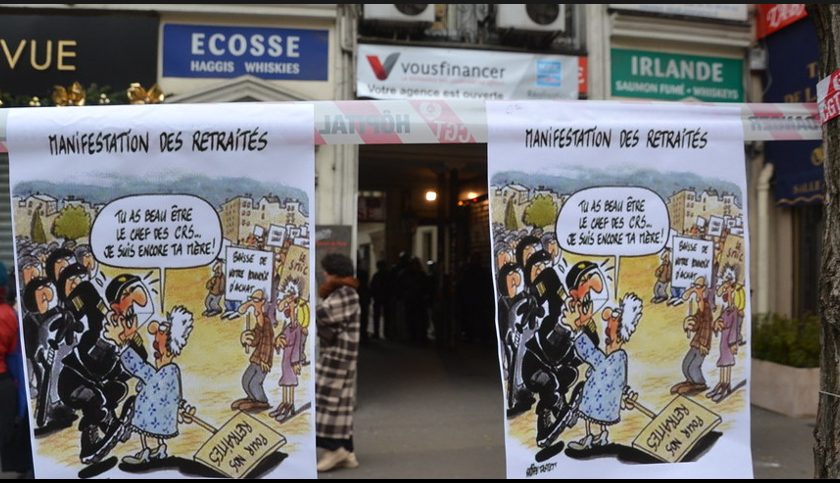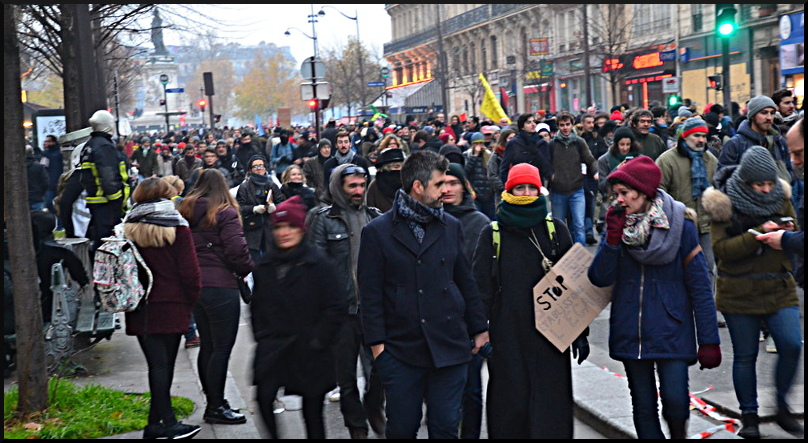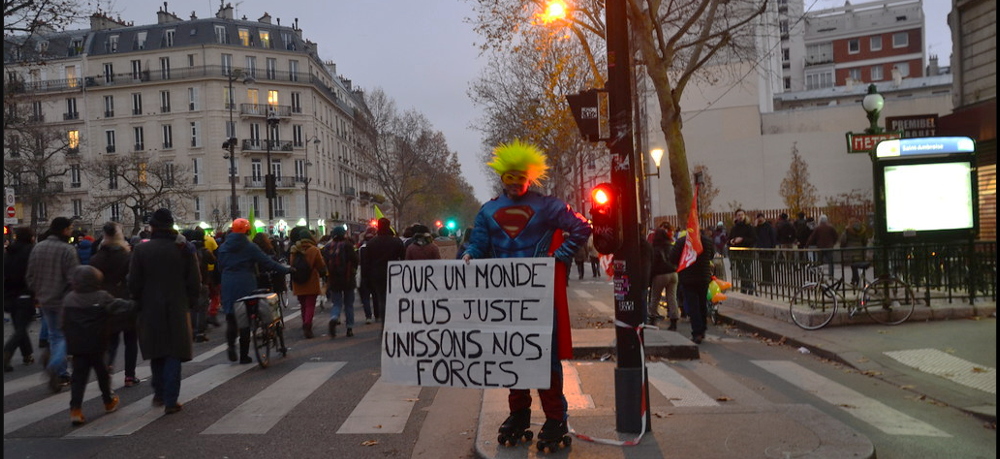by Marty Goodman, published on Socialist Action, January 2, 2020
On December 5th, French workers walked off the job in massive numbers to protest a proposed attack on pension rights by French President Emmanuel Macron. The proposal would change the age required for public workers to receive full retirement benefits from 62 to 64. French Prime Minister Edouard Philippe bluntly told the French working class after the strikes began,
“You’re going to have to work longer.”
Since the strike began, mass transit in major cities have been paralyzed; schools, hospitals, pharmacies and oil refineries closed or only offering limited service. Some electrical power lines have been turned off. Truckers are on strike too protesting a new fuel tax, and jamming roads for miles across France.
Many observers say a strike of this size has not been seen in France for at least 50 years, since the giant strike of May 1968 that involved up to 10 million workers.
Even though the changes are targeting public workers, private workers understand that retirement affects everyone and have joined in the mass demonstrations too.
According to government estimates, some 800,000 marched Dec. 5 nationwide, 1.5 million according to the CGT labor federation. More than 100 cities participated.
On Dec.17, as the strike entered its 13th day, hundreds of thousands mobilized in the streets. ABC news reported,
“Hospital workers in scrubs, Air France staff in uniforms, lawyers wearing long black robes — people from across the French workforce joined in the strikes and protests in higher numbers than the last cross-sector walkout last week.”
Even Opera performers and ballerinas were out on strike. The tourist mecca, the Eiffel Tower, was closed for a second time. Militant electrical workers were said to have cut power to select locations.
Shipping companies reported,
“Stoppages this week by tug-boat personnel and dock workers have hampered activity at major shipping hubs like Le Havre and Marseille.” (Dec.23)
One demonstrator, Ludovic Varlet, a hospital worker in Paris, said that he was angry with Mr. Macron and remarked that,
“It’s him and everything he represents,” adding: “Finance is governing. It was the best [pension] system in the world. And they are about to destroy it.”
Teachers at the Balzac school in Paris said in a statement they were striking against a reform
“that concerns all employees, in the public and the private sectors, and much later, our students. Work counts and needs respect,” it said. “Retirement pensions should be an enduring and definitive sign of respect for the accomplishment of years of work.”
Laurent Berger, head of the reformist CFDT union federation, said that society today is more explosive than in May 1995, a year of massive strikes that stopped Alain Juppé, the Prime Minister and President Jacques Chirac, from implementing a restructuring of the rail system, known as the Juppé Plan.
Said the economist Daniel Cohen of France’s top-ranked École Normale Supérieure,
“The government has inflamed unease with this reform. It is the other France that is revolting today,”
Resistance to Macron’s attack is being led by the public subway workers of the RATP (Parisian Public Transport Company) and the employees of the nationalized regional train system, SNCF (French National Railways). Both workforces are overwhelmingly members of the Left-leaning labor federation, the General Confederation of Labor (CGT). Although not officially part of the Dec. 5 action, the strike was joined on Dec. 17 by the more moderate Democratic Labor Confederation (CFDT), France’s largest labor federation. The CFDT’s Secretary General, Laurent Berger, said “a red line [had] been crossed” by Macron. Also participating in strikes are the unions Workers Force (FO), Solidarity and the United Union Federation (FSU).

On Dec. 16, in a major blow to Macron and his “En marche” party, the architect of Macron’s pension “reform,” Jean-Paul Delevoye, admitted that he had supposedly “forgot” to inform the government that he was part of an insurance firm that stood to benefit greatly from the pension changes. He resigned to avoid any “misunderstanding.”
Indeed, the pension cuts, set to begin in 2027, will rob retirees of billions a year in euros (1 euro=$1.11). After Macron’s election in May 2017, during his first year in office, Macron also abolished a wealth tax – a la Donald Trump – worth billions and made it easier for companies to hire and fire.
The massive strike and marches in December were a giant display of fury against French President Emmanuel Macron and his labor hating agenda that has not been seen since the massive strikes in 1995, which defeated similar attacks on the SNCF rail system and worker’s benefits by conservative President Jacques Chirac.
Essential to winning any strike is public support. Polls say that public support – code for working class support – for the ongoing strike, despite its inconveniences, has actually increased since it began. [As of this writing (Dec. 22), the unions have not said they will suspend the strike during the holidays.] The next big mass mobilization is scheduled for January 9.
President Macron, a millionaire investment banker, is proposing the pension changes to be determined by a “point” system accrued by working, a method unions denounce as unjust. Amongst the union’s objections, points would not be accrued if unemployed. France’s unemployment is currently 8.4%.
“We have two clashing perspectives,” said CGT General Secretary Philippe Martinez, “We don’t have the same values” and “the government has ridiculed the people.” Macron has declared that he was “total” in his commitment to so-called pension “reform.”
Negotiations between the Macron administration and labor have thus far not resulted in significant concessions on either side.
It should be understood that the CFDC federation has agreed to a point system in principle and objects only to moving back the year of retirement for full benefits. The CGT opposes both. It is for certain that Macron will seek to exploit the differences between the two labor federations.
The pension cuts are driven by Macron’s neo-liberal mania but also by the diktat of the International Monetary Fund (IMF), the enforcement arm of the U.S. dominated World Bank, and directives from the European Union (EU), both of which have told France that it must slash funding and services to working people.

Obviously there is a crisis of confidence in French society that the strike reflects. Last year, the “Yellow Vest” movement, a leaderless movement with somewhat vague, populist demands, that posed a challenge to France’s elite and its politicians. It mobilized 400,000 protestors on November 17, 2018 and demonstrated through 2019. Their numbers declined but the current upsurge has begun to, at least in part, reinvigorate at least some in the movement.
In 2018, Macron was more successful in selling his message – using the age-old bosses’ tactic of divide and conquer – declaring that the SNCF’s decades-old, jobs-for-life protections cannot go on, as if there was some elite privilege at having a job!
The rail strikes that followed in the spring and summer of 2018 were big but sporadic. Union bureaucrats announced to the capitalist class the timing of the strikes, giving them plenty of notice to prepare a response. Macron has insisted that rail “liberalization,” read rail privatization, is obligatory under European Union rules, France being behind other member states.
The strike needs to be uninterrupted and not rely on the on-again, off-again strike strategy that failed in 2018. In reality, none of the big union leaderships, including the CGT’s Martinez or the CFDT’s Berger, can be counted on to lead to a fight to the finish. A real fight must be based on democratic worker assemblies that decide strategy.
Only united mass action can defeat the capitalist austerity of Macron and the rest of the phony bourgeois politicians. The whole rotten system has got to go!
*All Photos: December 5, 2019 – Mass strikes and protests in France over pension reform (a disastrous reform driven by Macron and his wealthy friends). More than a million protesters throughout France.
In Paris a gigantic demonstration, cut in two at “Place de la République” by the obstruction of the police… before the march really began … So there were two huge demos in Paris, one at north of the Republic Square (where there were tens of thousands of protesters behind the union banners), and another part of the demo south of the Republic Square, where were still tens of thousands of protesters, without the sound and the vehicles of the trade unionists, but with a lot of voices and words and shouting in defense of our pensions. ~Jeanne Menjoulet/Flikr
Marty Goodman is a longtime socialist, community organizer and activist in the labour movement social movements and anti-imperialist struggles. His articles frequently appear on Socialist Action Blog
